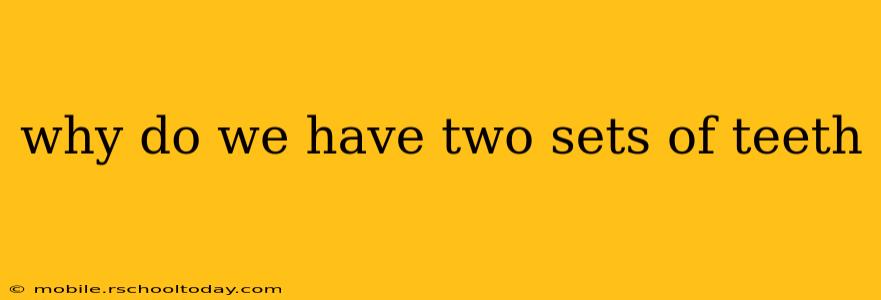Humans, unlike many animals, are diphyodonts – meaning we develop two sets of teeth during our lifetime: a set of primary teeth (also known as deciduous teeth, milk teeth, or baby teeth) and a set of permanent teeth. This unique characteristic isn't arbitrary; it's a crucial aspect of our growth and development, intricately linked to our changing nutritional needs and facial growth. But why this two-stage process? Let's delve into the reasons.
What's the Purpose of Baby Teeth?
Our first set of teeth, the primary dentition, typically begins erupting around six months of age and comprises 20 teeth. These aren't just placeholders; they serve vital functions:
- Mastication (Chewing): Baby teeth allow infants and toddlers to chew and digest food, facilitating their nutritional intake as they transition from liquid diets to solids.
- Speech Development: The presence of these teeth plays a critical role in the development of clear speech patterns. The tongue and jaw muscles learn to manipulate the teeth, contributing to articulation.
- Jaw Development: Perhaps the most crucial function, the primary teeth act as space maintainers, guiding the development and growth of the jawbones. They reserve space for the larger permanent teeth to erupt later. If a baby tooth is lost prematurely, the adjacent teeth can drift into the gap, potentially causing overcrowding in the permanent dentition.
- Facial Aesthetics: While not directly related to function, the presence of baby teeth contributes to the overall facial structure and aesthetics of a young child.
Why Do We Need Permanent Teeth?
The permanent dentition, consisting of 32 teeth (including wisdom teeth), gradually replaces the primary teeth. This transition typically begins around the age of six and continues into the early twenties. The reasons for the permanent set are manifold:
- Increased Chewing Efficiency: Permanent teeth are larger, stronger, and better suited for chewing a wider variety of foods. This allows for more efficient processing of food and better digestion.
- Adult-like Functions: Permanent teeth are essential for functions requiring more robust mastication, like biting and grinding tougher foods. They also enhance the precision needed for articulate speech.
- Long-term Oral Health: Designed for longevity, permanent teeth are intended to last a lifetime with proper care.
When Do Baby Teeth Fall Out?
This process is usually gradual, beginning around age six with the lower central incisors. The timing varies slightly from child to child, but generally follows a predictable pattern. The complete shedding of baby teeth typically finishes by the age of 12 or 13.
What Happens if Baby Teeth Are Lost Too Early?
Premature loss of primary teeth can lead to several issues:
- Spacing Problems: Neighboring teeth can shift into the empty space, potentially causing overcrowding of the permanent teeth when they erupt.
- Malocclusion (Bad Bite): This can lead to misalignment of teeth and jaws, requiring orthodontic intervention.
- Delayed Eruption of Permanent Teeth: The lack of space maintainers can delay the eruption of the permanent teeth.
Are Wisdom Teeth Necessary?
Wisdom teeth, the last molars to erupt, are often considered vestigial – a leftover from our evolutionary past. Many individuals lack the space in their jaws for these teeth to erupt properly, leading to impaction, pain, and potential infection. Therefore, they are often extracted.
In summary, the two sets of teeth represent a fascinating aspect of human development. The primary teeth serve crucial roles in nutrition, speech development, and jaw growth, paving the way for the stronger, more permanent dentition that supports our adult lives. Understanding this process is key to maintaining healthy teeth and gums throughout life.
